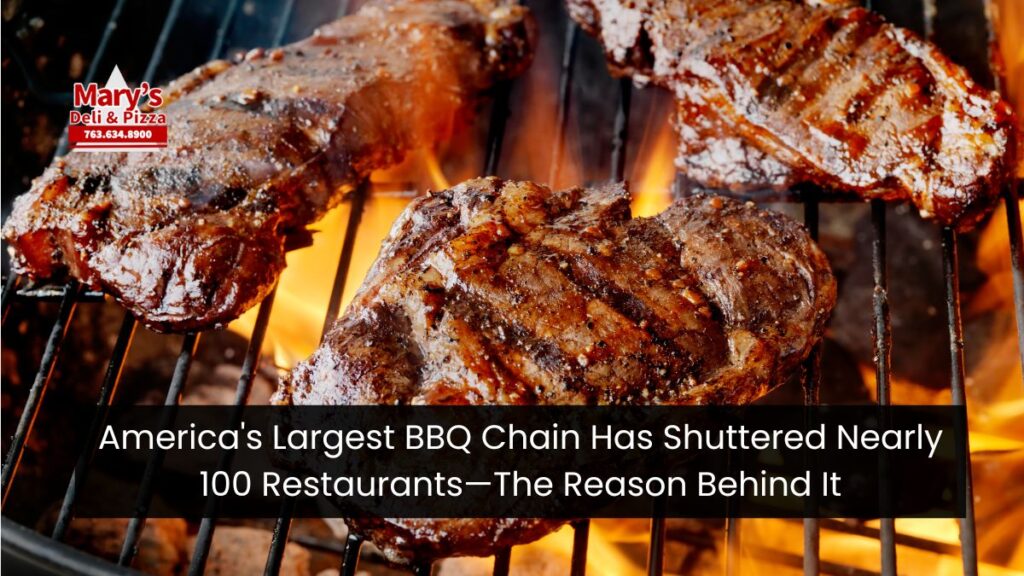The restaurant industry is facing significant changes in 2024, and one major player is feeling the impact. Dickey’s Barbecue Pit, the nation’s largest BBQ chain, recently shuttered close to 100 of its locations, marking a substantial contraction in its U.S. presence.
In a single fiscal year, the chain closed 97 locations, effectively reducing its footprint by 19% across the United States.
This wave of closures is notable because Dickey’s Barbecue Pit has historically been an aggressive franchise-expansion success story. However, the challenges faced by the chain in recent years have caused a shift in strategy.
The Numbers Behind The Closures
Dickey’s Barbecue Pit’s fiscal year ended on May 31, 2024, during which 97 locations were closed, according to its Franchise Disclosure Document (FDD).
When factoring in new openings, the net closure number stood at 85 restaurants. To put this in perspective, the chain started the fiscal year with 451 U.S. locations and ended with 366. This means that nearly one-fifth of its U.S. locations were shuttered in just one year.
Additionally, the FDD revealed that 106 Dickey’s locations were sold to other franchisees during this period, meaning that 46% of its U.S. restaurants either closed or changed hands in the fiscal year. These figures underscore a major reorganization within the chain.
Dickey’s currently operates 866 locations across all eight of its restaurant brands, including Wing Boss, Big Deal Burger, and Trailer Birds, in addition to the flagship Dickey’s Barbecue Pit.
Despite the closures, Dickey’s Barbecue Pit still maintains 366 U.S. locations and 19 international outposts, bringing the total to 385 locations globally.
Why Did Dickey’s Close So Many Locations?
The significant number of closures wasn’t an accident. Dickey’s Barbecue Pit made a deliberate effort to “clean up” and stabilize its franchise operations, according to Jeff Gruber, senior vice president of franchise relations at Dickey’s.
Gruber emphasized that the company has been focused on strengthening its core business by terminating agreements with underperforming or non-compliant franchisees, closing many of its virtual kitchens, and ensuring that current franchisees are better suited for long-term success.
Gruber explained that this was part of a strategy to improve the overall health of the business. The chain took a “back-to-basics” approach, focusing on its core strengths before setting its sights on growth again.
He noted, “We listened to our operators and made the strategic decision to strengthen our core before growing again.”
Part of this clean-up process also involved supporting franchise owners in enhancing operations, as well as ensuring that multi-unit operators who want to expand are in the best position to do so.
The company also plans to assist franchisees with store upgrade costs, advertising initiatives, and menu launches to further stabilize its existing operations.
Financial Troubles And Franchisee Struggles
Dickey’s financial performance has been a mixed bag in recent years, adding to the reasons for these closures. Restaurant Business Magazine reported that Dickey’s U.S.
system sales dropped by more than 5%, while unit volumes dropped by 3.6% from 2022 to 2023. These declines highlight the financial pressures that may have contributed to the decision to shutter some locations.
In addition to financial challenges, Dickey’s has faced issues with some franchise operators. For instance, Smokin’ Dutchman Holdings, a four-unit franchisee, filed for bankruptcy recently, illustrating some of the operational difficulties faced by individual franchise owners within the chain.
The financial woes, coupled with the logistical and operational challenges from some franchisees, have painted a clear picture that a massive internal restructuring was necessary.
What’s Next For Dickey’s?
Despite the closures, Dickey’s Barbecue Pit isn’t stepping away from future growth altogether. The company plans to open four new locations in the next fiscal year, focusing on expanding in areas where it believes it can succeed.
The chain is also working with both new and existing franchisees to improve performance, offer advertising support, and even reopen some locations that are currently closed but may become viable again.
Gruber was optimistic about the chain’s future, saying that no further major closures are anticipated. “We do not anticipate further closures.
We are working with many new and existing owners on opening new locations, and even reopening some locations that are temporarily closed,” he said.
The company’s aim is to come out of this period stronger, with the right operators running each restaurant and a more focused approach to providing support to franchisees.
The Broader Restaurant Industry Context
Dickey’s isn’t alone in facing challenges. The restaurant industry as a whole is undergoing a period of significant change, with several other chains also shuttering locations or filing for bankruptcy.
For example, Buca di Beppo, a popular Italian chain, recently closed 13 of its struggling locations and filed for Chapter 11 bankruptcy protection. Similarly, Noodles & Company is planning to close 10 to 15 restaurants in the 2024 fiscal year as part of efforts to shore up its business.
The impact of rising costs, shifting consumer preferences, and post-pandemic market dynamics have forced many restaurant chains to reassess their business strategies, focusing on long-term sustainability rather than immediate expansion.
Final Thoughts
Dickey’s Barbecue Pit’s decision to close nearly 100 locations in 2024 reflects the broader challenges faced by many restaurant chains today.
While the closures represent a significant contraction for the country’s largest BBQ chain, they are part of a larger effort to stabilize operations and position the company for long-term success.
By focusing on quality control, better franchise management, and stronger financial footing, Dickey’s hopes to re-enter a period of steady growth in the future.
Despite these closures, Dickey’s is optimistic about its future, with plans for new store openings, franchisee support, and even the reopening of temporarily closed locations. As the restaurant industry continues to evolve, it will be interesting to see how chains like Dickey’s navigate the road ahead.






